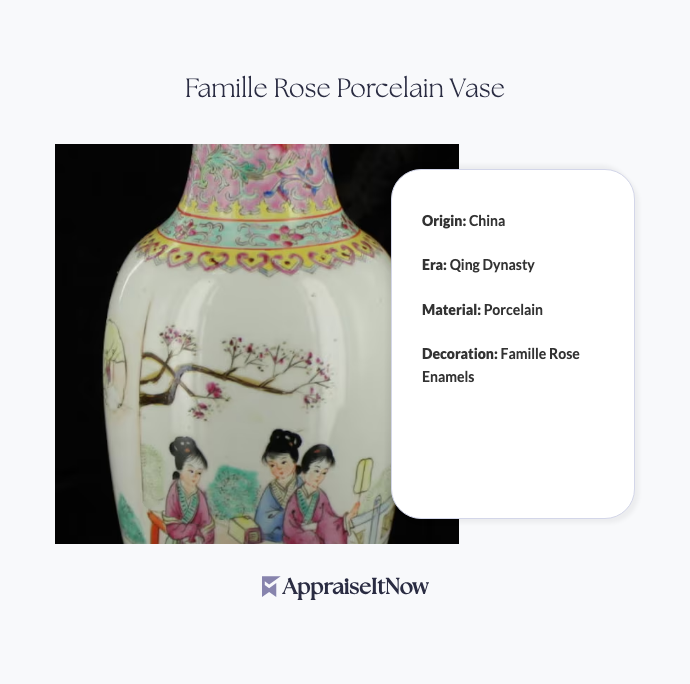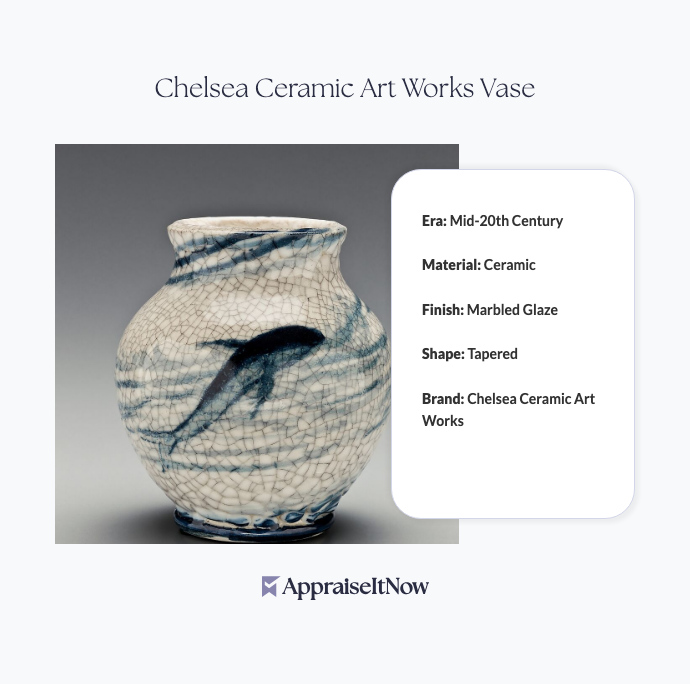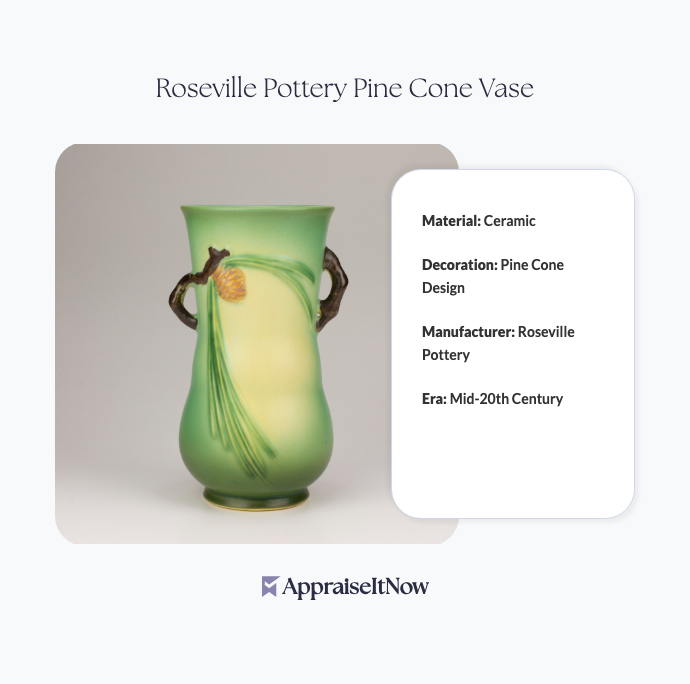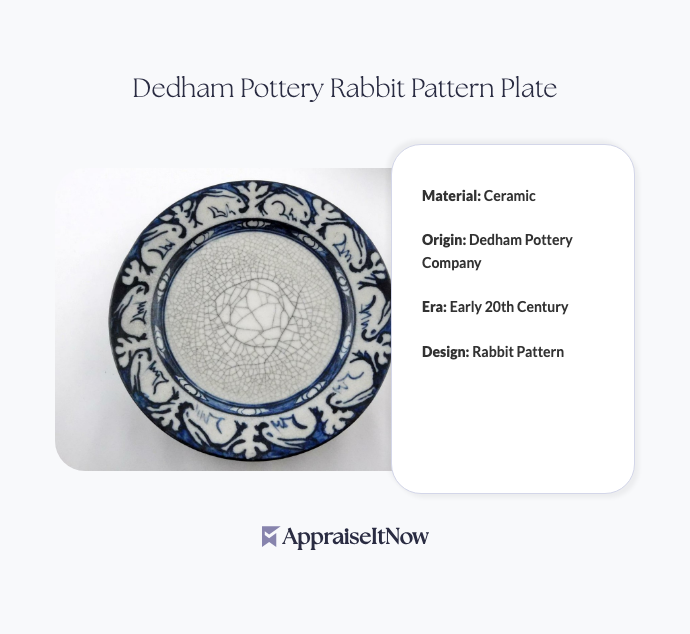<h1>How to Get Your Famille Rose Porcelain Vase Appraised</h1>
<p>If you've inherited a beautiful Chinese porcelain vase or recently acquired what you believe might be a Famille Rose piece, understanding its value requires professional expertise. A certified appraisal can reveal whether your vase is worth <strong>$5,000 to $7,000</strong> or significantly more, depending on its age, condition, and provenance. Whether you're considering selling, seeking insurance coverage, or simply want to understand what you own, getting your Famille Rose vase properly appraised is an essential first step.</p>
<h2>Understanding Famille Rose: What Makes It Valuable</h2>
<p>Famille Rose represents one of the most sought-after styles in Chinese ceramic history. This distinctive enamel technique emerged during the Qing Dynasty, characterized by vibrant pink-hued pigments that blend beautifully with other colors to create stunning visual depth. Your vase's value depends significantly on recognizing authentic Famille Rose craftsmanship and understanding the historical context that makes these pieces so desirable among collectors.</p>
<p>The technique first appeared in the 18th century and reached its peak during the 1700s and 1800s, a period when master artisans perfected the delicate hand-painted floral patterns you see on genuine examples. The intricate designs and graceful shapes reflect exceptional craftsmanship that commands respect in today's antiques market. Understanding these characteristics helps you appreciate why professional evaluation matters—not all pink-hued Chinese porcelain qualifies as true Famille Rose, and distinguishing authentic pieces from later reproductions requires trained eyes.</p>
<div class="callout tip"><p><strong>Collector's Insight</strong></p>
<p>Famille Rose vases with documented provenance and exceptional condition can exceed the $5,000-$7,000 baseline significantly, sometimes reaching $15,000 or more at auction.</p></div>
<h2>Identifying Authentic Famille Rose Before Getting Your Vase Appraised</h2>
<p>Before scheduling a professional appraisal, understanding how to identify an antique Famille Rose vase helps you gather the right information and ask informed questions. Authentic Famille Rose pieces display several distinctive characteristics that trained appraisers use to verify age and authenticity.</p>
<p>The most recognizable feature is the extensive use of pink enamel in the palette, derived from colloidal gold—a technique unique to Chinese ceramics of this period. Look closely at your vase's decorative patterns; genuine Famille Rose features intricate floral scenes with birds, butterflies, and delicate landscape elements rendered with remarkable precision. The pink tones should blend seamlessly with other colors including green, yellow, and blue, creating a harmonious composition rather than appearing flat or poorly integrated.</p>
<h3>What Age Markers Matter for Valuation?</h3>
<p>Dating your Famille Rose vase accurately significantly impacts its appraised value. Pieces from the 18th century command substantial premiums over 19th-century examples, though both periods represent genuine collectible pieces. When examining your vase, consider the shape and proportions—earlier examples typically feature more elegant, refined forms, while later productions sometimes demonstrate slightly less refined proportions. The base and foot deserve careful inspection; authentic period pieces show appropriate wear patterns consistent with age, while reproductions often display suspiciously uniform or overly pristine bases.</p>
<p>Understanding what a number on the bottom of a vase means helps you decode maker's marks and dating information. Some Famille Rose vases include imperial reign marks indicating manufacture during specific dynasties, though these marks weren't always accurate even when the vase was made. A professional appraiser can interpret these marks accurately, determining whether they match the vase's actual construction period.</p>
<h2>Why Porcelain Marks Matter in Your Appraisal</h2>
<p>The marks on your vase's base provide crucial information for valuation. While some collectors wonder what the most valuable porcelain marks are, the answer depends on matching the mark to verified manufacturing periods and imperial seals. Famille Rose pieces with clear, readable marks from the Kangxi, Yongzheng, or Qianlong reigns typically carry significant value premiums, as these emperors ruled during the height of Famille Rose production and artistic refinement.</p>
<p>However, many valuable Famille Rose vases lack clear markings or carry period-appropriate marks that don't necessarily indicate imperial manufacture. Professional appraisers understand that unmarked or ambiguously marked pieces can still be highly authentic and valuable. They evaluate the vase holistically—considering form, decoration, material quality, and construction techniques rather than relying solely on marks.</p>
<div class="callout note"><p><strong>Important Detail</strong></p>
<p>Some Famille Rose vases carry marks from earlier periods than when they were actually made, a common practice among Chinese artisans who respected historical traditions.</p></div>
<h2>Assessing Your Vase's Condition for Appraisal</h2>
<p>Condition dramatically affects your Famille Rose vase's appraised value. The finest examples command premium prices, while even minor damage can reduce values significantly. Understanding what appraisers look for during condition assessment helps you present your piece appropriately when seeking professional evaluation.</p>
<p>Examine your vase carefully for cracks, chips, or repairs. Even hairline cracks invisible to casual observation can affect value substantially. Look at the glaze surface for chips on the rim, foot, or body. Restoration work, particularly professional museum-quality restoration, may preserve some value better than visible damage, but appraisers will note and document any repairs. The interior should also be examined; accumulated residue or staining may indicate the vase was used functionally rather than displayed, though this generally doesn't significantly impact collectible value for Famille Rose pieces.</p>
<p>Paint degradation represents another consideration appraisers evaluate. Original enamel colors should appear vibrant and well-adhered to the porcelain body. Areas where decorative painting has worn away or faded suggest age and use, which can be consistent with authenticity, but excessive fading or flaking may indicate issues with glaze adhesion or earlier restoration attempts.</p>
<h2>Determining Age Through Construction Analysis</h2>
<p>How to date Famille Rose porcelain accurately requires understanding construction techniques that evolved over time. The thickness and weight of the porcelain body, the potting technique used to form the vase, and the glaze application all provide dating clues that professional appraisers use to establish authenticity and period.</p>
<p>Earlier 18th-century Famille Rose vases typically display lighter, more refined construction than later examples. The porcelain feels smooth and refined to touch, with walls of consistent thickness that suggest careful hand-throwing by experienced potters. Glaze consistency and quality also indicate period—authentic period pieces show appropriate wear patterns on bases where kiln supports contacted the vase, and natural variations in glaze color and texture created during the firing process.</p>
<p>Professional appraisers specializing in <a href="/blog/appraisals-for-fine-porcelain-and-ceramics-valuing-delicate-artistry">fine porcelain and ceramics</a> use magnification tools to examine these details closely, identifying manufacturing techniques and materials that reveal a vase's actual age. This expert analysis provides documentation essential for insurance, sale, or authentication purposes.</p>
<h2>Comparing Your Vase to Similar Examples</h2>
<p>Understanding comparable sales helps you establish realistic value expectations before scheduling an appraisal. Recent auction results for similar Famille Rose vases indicate the current market value range, though individual pieces vary based on specific characteristics and condition.</p>
<p>When researching comparable pieces, pay attention to size and form—your vase's specific shape significantly affects its appeal to collectors. Baluster vases, bottle vases, and shouldered forms each command different price points within the Famille Rose category. Similarly, the decorative subject matter influences value; certain themes or compositions may be more or less sought-after by collectors. Appraisers use this comparative market analysis to support their final valuation, referencing recent sales of similar pieces from reputable auction houses and dealers.</p>
<div class="callout tip"><p><strong>Research Strategy</strong></p>
<p>Document auction results for vases matching your piece's approximate date, size, and condition to understand the market context your appraiser will consider.</p></div>
<h2>The Role of Provenance in Famille Rose Appraisals</h2>
<p>If you know your vase's ownership history, this provenance information becomes valuable documentation during appraisal. Pieces with documented collecting history, particularly those from notable collections, museums, or respected dealers, often command significant premiums. Your appraiser will want to know where your vase came from, how long you've owned it, and whether any documentation exists regarding previous ownership.</p>
<p>Provenance documentation doesn't require famous previous owners to add value—consistent ownership records simply provide confidence in authenticity and condition history. If your vase was recently purchased from an auction house, gallery, or established dealer, gather any certificates or condition reports they provided. These documents support your appraisal and demonstrate appropriate due diligence in acquisition.</p>
<h2>Avoiding Common Mistakes That Affect Valuation</h2>
<p>Understanding what reduces Famille Rose vase values helps you protect your piece and understand appraisal results. Improper cleaning or restoration, particularly amateur attempts to repair damage or restore decoration, significantly reduces value compared to leaving a piece in its original condition, even with visible wear.</p>
<p>The difference between rose medallion and Famille Rose sometimes confuses newer collectors. While both styles feature beautiful rose-toned enamels, Rose Medallion emerged later (19th century) and typically displays symmetrical cartouches, whereas Famille Rose features more naturalistic compositions. Misidentifying your vase's style would lead to incorrect valuation, making professional appraisal essential for accurate classification.</p>
<p>Similarly, avoid attempting to enhance your vase's appearance before appraisal. Harsh cleaning can damage the enamel decoration, and any restoration attempts should be disclosed to your appraiser. Present your piece in its authentic condition so the professional evaluation reflects its true market value rather than speculative improvement attempts.</p>
<h2>Selecting a Qualified Appraiser for Your Famille Rose Vase</h2>
<p>Finding an appraiser experienced with <a href="/blog/appraising-asian-art-and-antiques-understanding-cultural-significance-and-value">Asian art and antiques</a> ensures accurate valuation of your Famille Rose vase. Look for appraisers holding credentials from recognized organizations like the American Society of Appraisers (ASA), International Society of Appraisers (ISA), or American Association of Appraisers (AAA). These certifications indicate the appraiser has met rigorous education and experience requirements specific to their specialty.</p>
<p>Your appraiser should demonstrate specific expertise in Chinese ceramics and Famille Rose porcelain. Ask about their experience with similar pieces, their methodology for dating and authentication, and their familiarity with current market conditions. A qualified appraiser will ask detailed questions about your vase's acquisition, provenance, and condition history, then provide thorough documentation of their evaluation process and reasoning.</p>
<p>When evaluating appraisal services, <a href="/types/antiques">AppraiseItNow</a> connects you with credentialed experts across the United States who specialize in <a href="/types/antique-artwork">antique artwork</a> and Asian ceramics. Their USPAP-compliant appraisals provide certified documentation accepted by insurance companies, auction houses, and legal institutions—essential if you're seeking insurance coverage or planning to sell your vase.</p>
<h2>What to Expect During the Appraisal Process</h2>
<p>Professional appraisers follow standardized procedures when evaluating Famille Rose vases. The process typically includes detailed visual inspection, discussion of provenance and condition history, comparative market analysis, and comprehensive documentation. Your appraiser will photograph your vase from multiple angles, document any marks or signatures, and note condition issues with precise descriptions.</p>
<p>The evaluation considers the vase's dimensions, weight, material composition, and construction details. Your appraiser may examine the vase under magnification to assess glaze quality, enamel adhesion, and construction techniques. They'll reference comparable recent sales, market demand, and current economic conditions when establishing fair market value. The final appraisal report documents all findings and provides a detailed justification for the concluded value, suitable for insurance, sale, or estate purposes.</p>
<div class="callout note"><p><strong>Key Takeaway</strong></p>
<p>A professional appraisal of your Famille Rose porcelain vase provides accurate valuation ($5,000-$7,000 or potentially much higher), authoritative authentication, and comprehensive documentation essential for insurance, sale, or estate planning. Expert evaluation ensures you understand the true value and historical significance of this beautiful piece of Chinese ceramic heritage.</p></div>







.avif)







